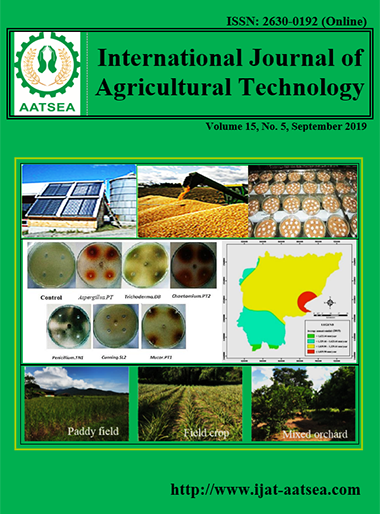Research and development of enzymatic producing fungi as biofertilizer for tea and arabica coffee production in Northern Vietnam
Main Article Content
Abstract
Tea (Camellia sinensis) and Arabica coffee (Coffea arabica) are main economic crops in the northern region of Vietnam, contributing for improving income of local farmers. However, the production activities of these crops in Vietnam are depended on agrochemical to maintain crop productivity that has led to many unexpected consequences on the environment, ecosystem, and human health. The potent enzymatic producing fungi were found, screened and developed to be biofertilizer product and used for tea and arabica coffee cultivation. Chaetomium PT2, Trichoderma DB, Mucor PT1, Cunninghamella SL2, Penicillum TN1, AspergillusPT were selected and all tested isolates produced cellulase, xylanase, and ligninase to degrade organic materials. Those isolates were developed to be organic biofertilizer product (BFP). In vivo trial, results in a greenhouse experiments showed that the bio-fertilizer product not only gave significant effects on growth of tea and coffee plants but also increased the organic matter in soil. The bio-fertilizer product could provide a good choice to apply on tea and coffee plants in Vietnam to decrease the application of chemical fertilizers.
Article Details

This work is licensed under a Creative Commons Attribution-NonCommercial-NoDerivatives 4.0 International License.
References
Al-Arequi, A. H. N. A., Chliyeh, M., Sghir, F., Touhami, A. O., Benkirane, R. and Douira, A. (2013). Diversity of arbuscular mycorrhizal fungi in the rhizosphere of Coffea arabica in the Republic of Yemen. Journal of Applied Biosciences, 64:4888-4901.
Debojyoti, R., Manibrata, P. and Sudip, K. B. (2017). Isolation identification and partial characterization of nitrogen fixing bacteria from soil and then the production of biofertilizer. International Journal for Research in Applied Science & Engineering Technology, 5:4021-4026.
Diriba, M. (2007). Microbial inputs in coffee (Coffea arabica L.) production systems, Southwestern Ethiopia. Doctoral thesis Swedish University of Agricultural Sciences.
Glory, S., Swarupa, Reddy, A. G. S. and Nagaraja, M. S. (1998). Effect of biofertilizer on growth performance of coffee seedlings. Fungy system, 3:6-8.
Ha, T. T., Cao, N. D., Tran, L. K. N., Nguyen, T. P., Mai, T. T. and Bui, T. V. (2008). Isolation of cellulose-degrading bacteria, starch and protein in leachate from the landfill in Can Tho city, Journal of Agriculture, Can Tho University Publisher.
Herman, S., Yulianita, P. I. L. and Mirajunnisa, A. Y. (2019). Potential of cellulase of Chatomium globosum for preparation and characterization of microcrystalline cellulose from water hyacinth (Eichhornia crassipes). International Journal Applied Pharma ceutics, 11:140-146.
Jayanta, B. P. and Mitra, S. R. (2016). Isolation and characterisation of Nitrogen Fixing Bacteria (Azotobacter sp.) from tea field soil of Dooars and Darjeeling region of North Bengal, India. International Journal of Engineering Science Invention, 5:46-51.
Kaewchai, S., Soytong, K. and Hyde, K. D. (2009). Mycofungicides and fungal biofertilizers. Fungal diversity, 38:25-50.
Kumar, P., Kumar, A. and Singh, R. (2018). Effect of sugar pressmud on the lignocellulolytic fungi. Progressive Agriculture, 18:283-286.
Nguyen, N. K. (2016). Effect of biomixture containing spent coffee ground and milled egg-shells on the yield of okra (Abelmoschus Esculentus Moench) and soil fertility under greenhouse conditions. International Journal on Advanced Science, Engineering and Information Technology, 6:495-501.
Padmavathi, T., Vaswati, N. and Puneet, A. (2012). Optimization of the medium for the production of cellulases by Aspergillus terreus and Mucor plumbeus European Journal of Experimental Biology, 2:1161-1170.
Pham, T. N. L. (2012). Microbiology practice curriculum. Hue University Publisher.
Pointing, S. B. (1999). Qualitative methods for the determination of lignocellulolytic enzyme production by tropical fungi. Fungal diversity.
Renla, T. and Ajungla, T. (2017). Camelia Sinensis ȍL.Ȏ O. Kuntze and Its Beneficial Soil Microflora, 5:1-4.
Tolan, J. S. and Foody, B. (1999). Cellulase from submerged fermentation. In Recent progress in bioconversion of lignocellulosics. Springer, Berlin, Heidelberg, pp.41-67.
Tran, T. L. (2012). Selection of Trichoderma spp fungi strongly resolve cellulose to produce micro-organic fertilizer and study their effect on green bean varieties in 2011 spring crops in Huong Long cooperative, Hue city. Journal of Science, Hue University Publisher, 71(2).
Vo, V. P. Q. and Cao, N. D. (2011). Isolate and identify cellulose-degrading bacteria. Journal of Science, Can Tho University Publisher, 18a:177-184.
Yeoh, H. H., Tan, T. K. and Tian, K. E. (1984). Cellulolytic enzymes of fungi isolated from wood materials. Mycopathologia, 87:51-55.
Zhang, L., Wang, Z., Ruan, Z. and Liu, Y. (2013). Fungal Cellulase/Xylanase Production and Corresponding Hydrolysis Using Pretreated Corn Stover as Substrates. Applied Biochermistry and Bioitechnology, 172:2.


